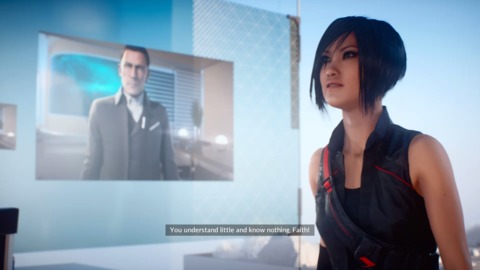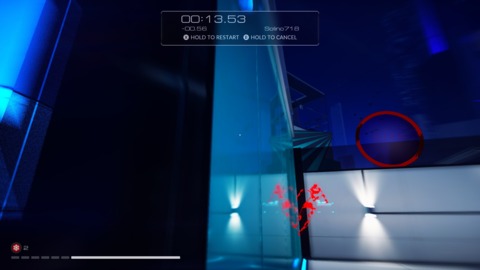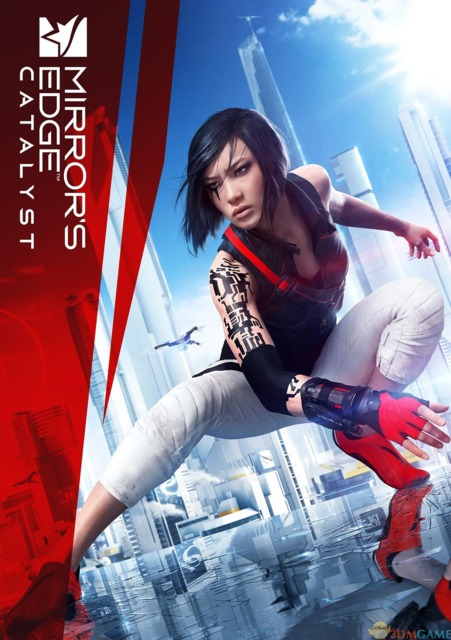Part-Time Gamers Review: Mirror's Edge Catalyst
By Neil Jimenez
When Mirror’s Edge made its debut in 2008, I was struck by how they made first-person platforming feel good. It had a wonderful sense of speed, simple to understand controls, and a more unique vision of the future than most sci-fi of today gives us. However, it was also deeply flawed, most notably by the inclusion of guns that turned the combat into a subpar first-person shooter that slowed down the action. With Mirror’s Edge Catalyst, we get to return to a world where the clean and minimalist aesthetics of the iStore become the norm, where the corporations are the government, and where beneath it all is a state based on surveillance and repression.

While Catalyst improves upon the original in almost every respect, the narrative is slightly worse. The game opens with Faith Conners, the player character, getting let out of juvenile prison. Within minutes she is getting back to being on the wrong side of the law and running across rooftops just like the good old days. At least, I assume that is true, because of how many characters told me I used to be a great runner. If this game was a sequel or even prequel, I would have more to go on, but the game is actually a complete narrative reboot. Combined with the push made to give the Mirror’s Edge franchise a presence across multiple mediums (there is a comic book series that tells the story about why Faith was in prison), the story feels incomplete. One prominent example is character Dogen, a crime boss, to whom Faith owes a lot of money because of something that happened before this game. The way Dogen treats Faith hints at a lot more than just owing money, but without that information, he ends up just seeming like a crazy person who sends you on a few missions. Another reason the story is lackluster compared to the first Mirror’s Edge stems from the biggest change Catalyst made; the open-world environment. To avoid any direct spoilers for the ending, I will just say that the climax and fallout from the narrative is swept under the rug in an extremely unsatisfying way.
However, making it an open-world environment does service the gameplay surprising well. Each area in of the map is constructed in a labyrinthine manner, allowing for many interesting routes from point A to point B. There are also lots of collectables scattered throughout the world, which highlight paths you might otherwise never notice or encourage figuring out the platforming puzzle to reach obscure areas. The only real problem with the world’s layout is the rather limited bridging between zones. Since the game gates off some zones with the grappling hook and its upgrades gained through the story, there are some bridges that must be traversed as the only way in or out. The biggest offender is the home base, which is not particularly interesting to run through, but required because of how the zones branch out from it.
When you open up the map, you will see a plethora of icons indicating side missions. Unfortunately, almost all boil down to a few variants of time trial. While the delivery missions flesh out the world by having the characters that give you the jobs talk to you a bit while you run, the fail conditions on these will cause the voice lines to repeat and become a bit annoying. The timed races that have a leaderboard focus are much less frustrating in this way, in part because they have no fail condition to force the restart, but also because their competitive nature lends itself well to a game about running fast. The story side missions are more interesting and varied, my favorite being the timed collection missions that set a smattering of glowing points around an environment and leave you alone to determine what path with allow you to grab them all.

The main story missions, on the other hand, bring back the more focused platforming paths of the original game. What lets them stand out is the dynamic nature of the environments. Since the city is built to exist as a playground to explore and run through, it is very static and unchanging. The story missions are allowed to destroy walls, trigger elevators you’re not riding, and build the pressure in ways other than a timer on top of the screen. They also take you to locations that are not able to fit into the open-world so seamlessly without a reasonable way to get back down, such as a skyscraper.
Catalyst still suffers from the combat; it slows down the action in a game that is about speed. The first big thing to note is that guns are not useable as they were in the first game. They have been replaced with a two-button light and strong melee system, as well as “traversal attacks” that gain strength with your focus meter. The focus meter builds up with movement and is also used to solve the problem of ranged enemies by acting as a shield. This ends up working really well since it encourages continuous movement, the game’s strong point. While there are a few sections throughout the story that do require you to engage in the combat, not all of them are using the combat at its worst. In fact, the times I was most annoyed by the combat was when I could see that it could be skipped, but engaging with it meant I could actually line up the jump I needed. Another good use of the combat is when the enemies are spread through an environment like an added layer of the platforming obstacles.

A few of the other additions to this installment of the franchise are erratic in their success. One of the good ones is in the multiplayer functionality. While the game has many premade races and routes with leaderboards to compete with, they also allow you to create your own race challenges within the world. This is a neat addition, and the interface for creating them is quite simple; hit a button while running around to create a checkpoint that must be passed. Some of the more questionable additions to the game include the ability trees. The movement tree begins with almost 80% already unlocked, and a few of the later upgrades are minor increases to basic abilities, like climbing ladders faster. The combat tree has a few helpful abilities, but also ends up being mostly passive boosts to the damage of attacks. And the Gear tree mostly unlocks automatically through the story’s progression. The whole thing feels tacked on and rather unneeded.
I was most surprised by was the addition of a fast-travel system to teleport to different areas of the world. While these are commonplace in most open-world games, Mirror’s Edge is a game in which traversing the world is the primary form of engagement. The strangest thing about this is that unlocking the ability for fast travel to a zone is tied to the completion of a Gridnode. The Gridnodes are some of the most fun platforming puzzles in the game, requiring you to vertically scale the insides of these large computing centers. Each has a theme, and most have more than one viable path to ascend. Because the Gridnodes are so good, making them optional is a mistake. Having them unlock a way to circumvent the core mechanic of the game is just confusing.
“You have been given a rare second chance. Make sure not to squander it.” These are the closing words of a short pre-recorded speech playing as Faith exit from juvenile prison in the city of Glass. While she does not get more than 100 feet from juvie before messing up, the developers at DICE did great work with their second try at the Mirror’s Edge franchise. There are a lot of smart design choices to keep the focus on what makes the game good: the movement. The game is not perfect, but I had a wonderfully fun time with it. I just hope it doesn’t take another eight years to get more.
